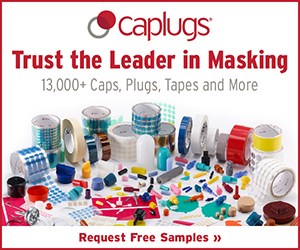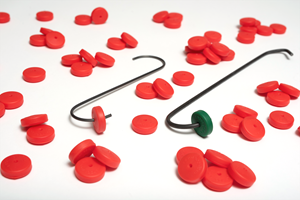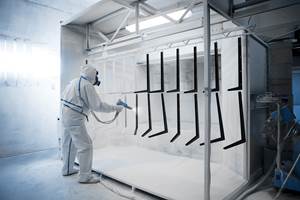Are Burn-Off Ovens Safe?
Steelman Industries’ Carlton Mann says burn-off ovens are safe, and he offers some considerations for installing one.
Q: Are burn-off ovens safe to operate in a plant?
A: People do often have concerns about the safety of burn-off (heat-cleaning) ovens in their facilities. After all, they are gas-fired, work at high temperatures and remove combustible materials from fixtures and parts. It seems like there are many ways things could go wrong.
However, burn-off ovens are extremely safe to operate, as proven by the roughly 10,000 that have been in operation around the country during the past 30 years. Here are a few reasons why they are so safe:
- They are built like incinerators, so any fire will be safely contained.
- They have primary and backup water spray systems to control the process and douse any potential fires.
- They have explosion relief doors on top that open to relieve pressure and then close to keep air from entering the oven.
Like any industrial equipment, there are potential dangers, however. To avoid them, the oven should be kept in good repair. This means fixing or replacing parts that are broken and never “jumping out” safety devices such as pressure or limit switches. Usually, the manufacturer will have a service department that can guide you through the repair process and send you the correct components.
You also should check the water sprays before each operation of the oven, making sure you see a fan-shaped mist from the primary sprays and a large fan from the backup. Never load sealed containers or other items that may have unvented cavities into ovens. Examples include structural tubing that might be part of a racking system and water-jacketed components. Also never load uncured paint or solvents into the oven. These materials will decompose all at once and overload the afterburner.
Another way to help avoid danger is to wait until the oven temperature is below 500°F before opening the doors. This assures that any combustible vapor still present in the oven will not ignite. If you open the door and see smoke, flame or glowing embers, close the door and wait until the burning has ended. The primary water sprays can be used to speed the cooling process. Be aware that the cart and parts inside the oven will be hot for some period after the doors are opened; protective gloves and gear should be used for unloading.
When planning for a burn-off oven, consider:
Location. This is the most important consideration. There should be plenty of space in front of the oven for loading and space around the oven for maintenance. An example of a bad installation is when the oven is placed through a wall, so the doors open into the plant, but the setup doesn’t include a door beside the oven for access to the burners and valves. This results in a service nightmare, with numerous long trips down the hall and out a door to get to the other end of the oven.
Burn-off ovens tend to be dirty with ash and pigment that remains after the burn. The pigment sticks tenaciously and is easily tracked around the plant, so, you should isolate the oven from your coating line to prevent cross-contamination.
Hooks and fixtures will have a coating of pigment after thermal cleaning, which needs to be removed before placing them back on the line. Be sure to locate the oven near a space where you can spray the parts with a pressure washer.
Some facilities place their ovens outside, under a roof. What they don’t consider is that the oven will get wet if the wind blows when it rains. In these locations, you should at least protect the control side of the oven, although totally enclosing it is best.
Utilities. You will require natural gas or propane fuel for heating the oven and water for control. Be sure that your gas meter and regulator are large enough to handle all the gas-fired equipment in your plant. Also be sure the pressure and piping are adequate for the oven before it’s delivered. It’s very frustrating to have your oven installed only to find out that your gas service is too small. Water usage on ovens is low, usually 1-5 gallons per minute on an as-needed basis. Problems can occur, however, when pressure fluctuates as spray washers are used or tanks are filled. Before your oven is delivered, check your pressure and see if it fluctuates during the day. If it does, it can be stabilized with a pressure tank and check valve. If it’s too low, a pump may be necessary.
Stack. The exhaust stack should go through the roof or through a sidewall and then extend above the roof. If the roof or building wall is made of combustible material, the wall cannot be closer than 2 feet from the stack. For combustible roofs, insulated thimbles are available that reduces this distance requirement.
Permits. You should apply for an operating permit with your state department of environmental quality before you purchase an oven to be sure that you will be allowed to operate it. The oven manufacturer can help you obtain such a permit.
Exhaust fans. If you have exhaust fans in your building, be sure that you have sufficient make-up air. If not, the fans will draw air down the stack and pull smoke out of the oven. This will cause the oven to malfunction because it’s starved for air. We get calls every year when the temperature drops and people close windows and doors that were providing make-up air in warmer weather.
Related Content
CFS Unveils New Hook Locks Parts Racking Solution
New product from Custom Fabricating & Supplies (CFS) prevents part loss during coating processes.
Read MoreThe Importance of Rack Maintenance
A look at how poor rack maintenance contributes to wasted time, wasted chemicals and wasted materials.
Read MoreHTE Powder Coatings Take Coverage to the Next Level
High-transfer efficient powder coatings deliver cost, time and energy savings.
Read MoreA Software Platform for Self-Programming, Autonomous Robotics
Omnirobotic is delivering an automation solution that could transform the way finishing shops consider robotics.
Read MoreRead Next
The 2024 Ford Mustang: All the Colors Available
Although Chevrolet has announced the end of the Camaro and Dodge is offering “Last Call” editions of the Charger and Challenger, the Ford Mustang is launching to its seventh generation.
Read MoreEpisode 42: An Interview with Robin Deal, Hubbard-Hall
Hubbard-Hall wastewater treatment specialist Robin Deal discusses the latest trends in wastewater management.
Read MorePowder Coating 4.0: Smarter, Faster, More Efficient and Connected
New tools reduce cost and waste, lower manufacturing footprint of powder coating operations.
Read More

























